人教版 (2019)选择性必修二 Unit 5 First Aid Learning About Language课件(共44张PPT)
文档属性
| 名称 | 人教版 (2019)选择性必修二 Unit 5 First Aid Learning About Language课件(共44张PPT) | 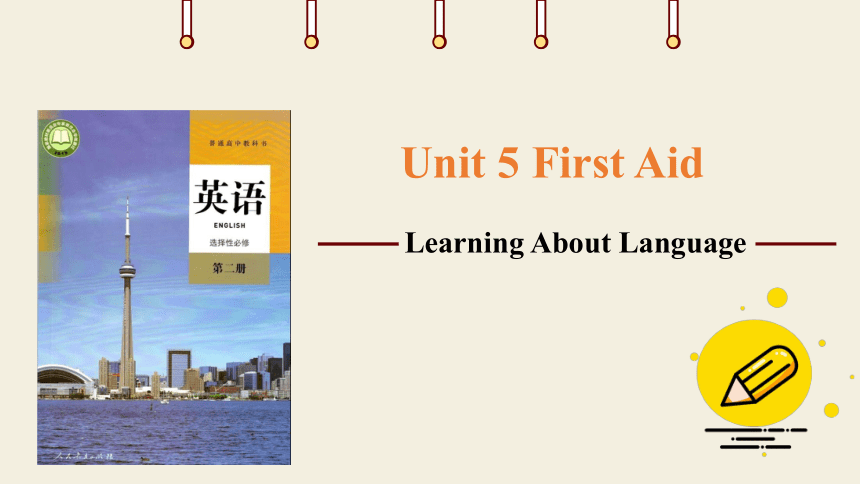 | |
| 格式 | pptx | ||
| 文件大小 | 6.0MB | ||
| 资源类型 | 教案 | ||
| 版本资源 | 人教版(2019) | ||
| 科目 | 英语 | ||
| 更新时间 | 2023-08-17 13:31:31 | ||
图片预览

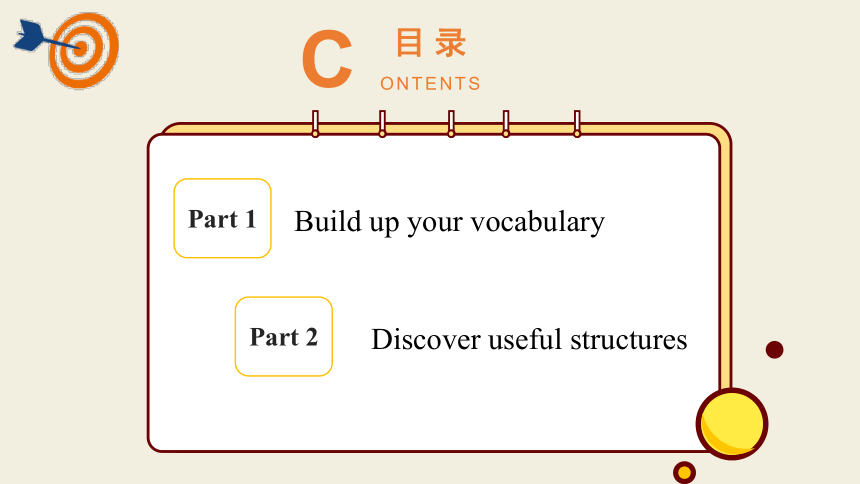
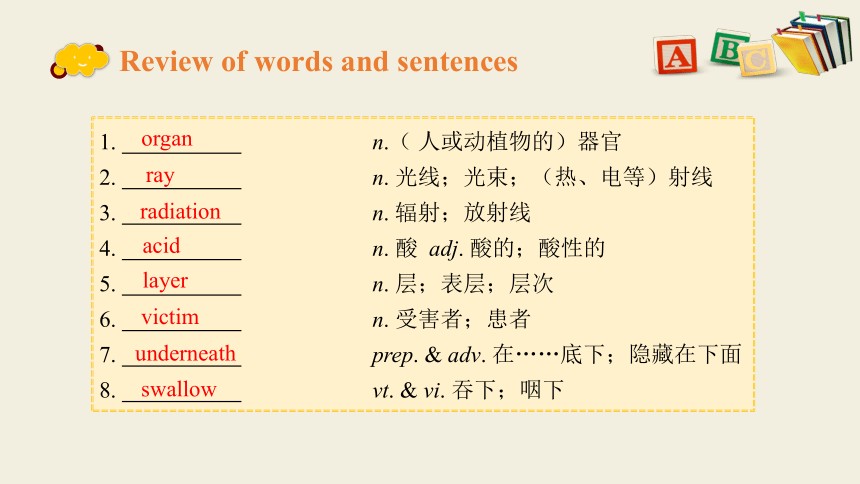
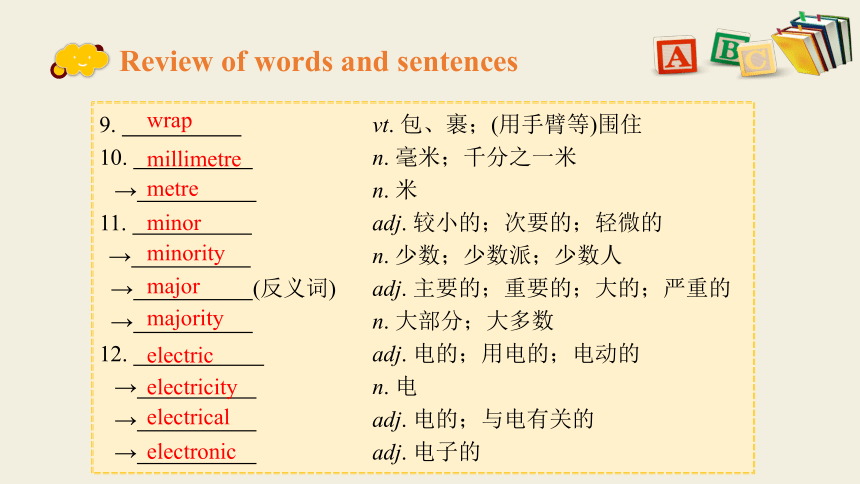
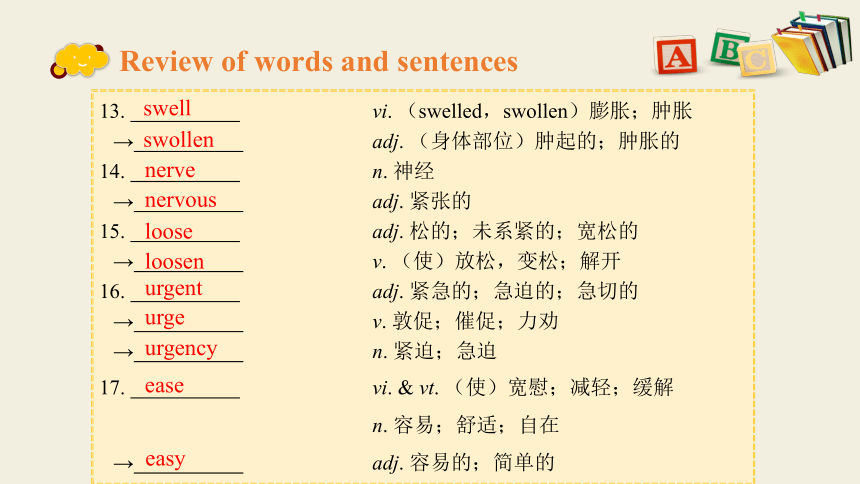
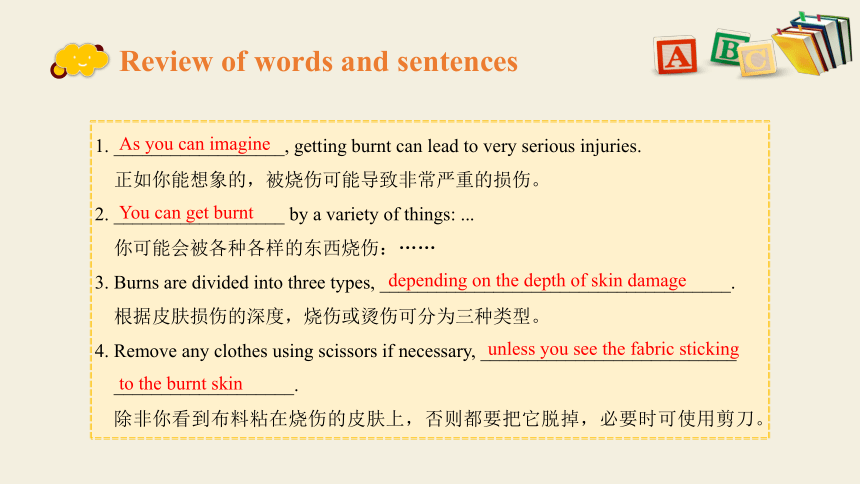
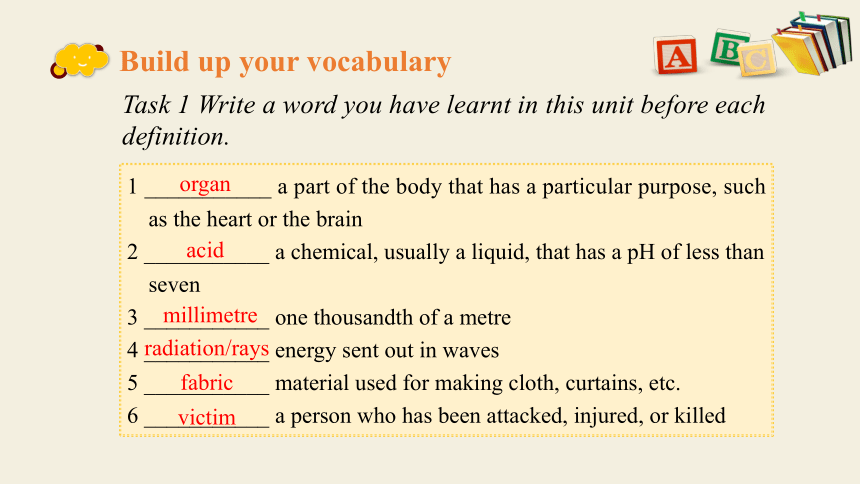
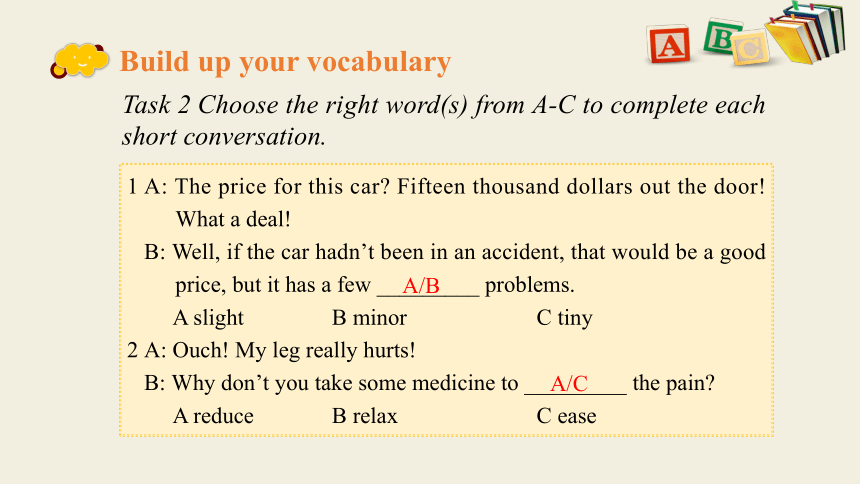
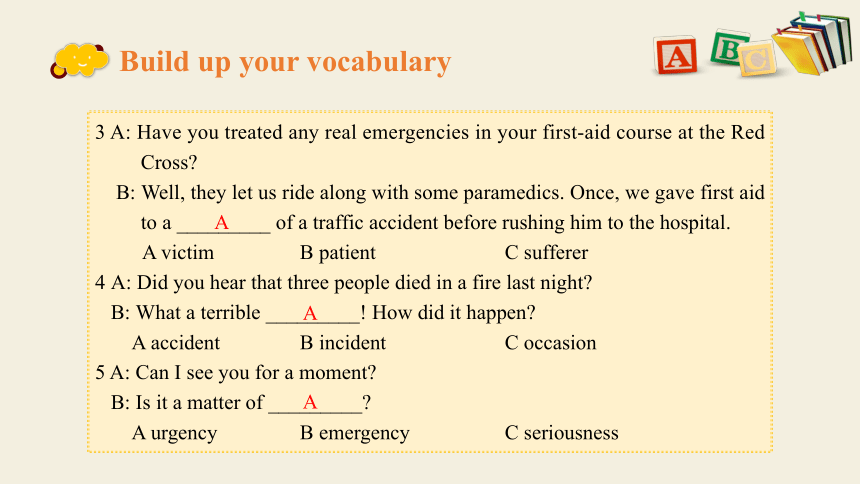
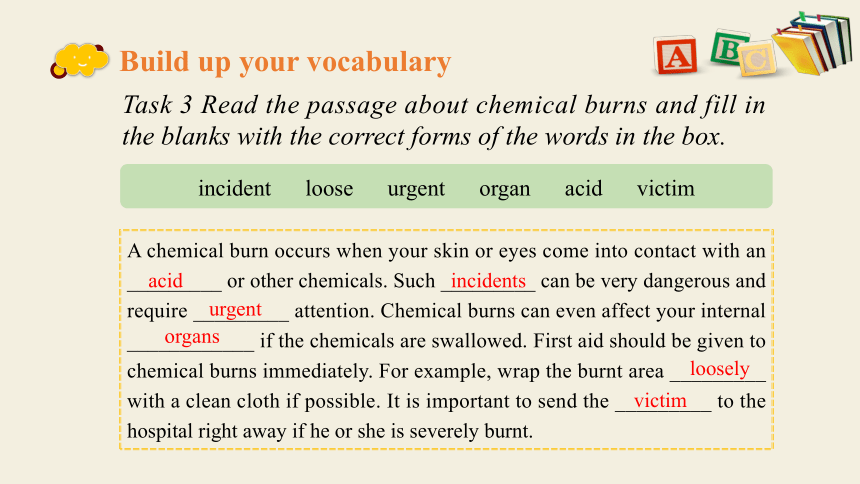
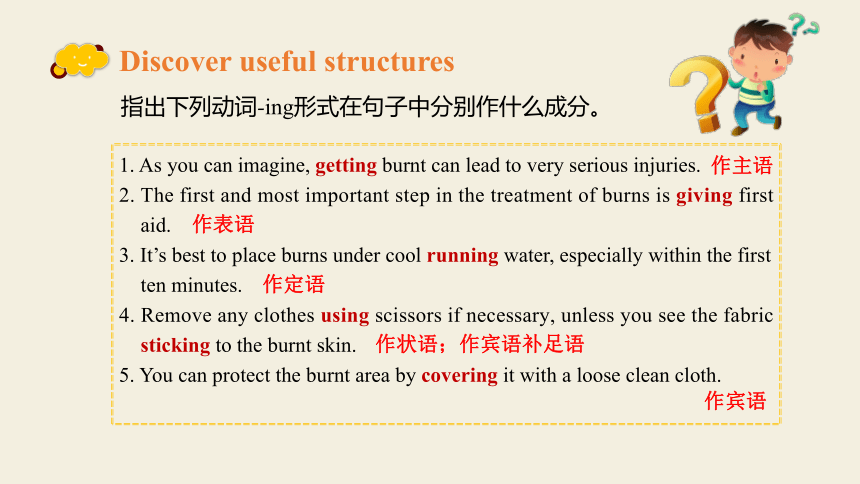
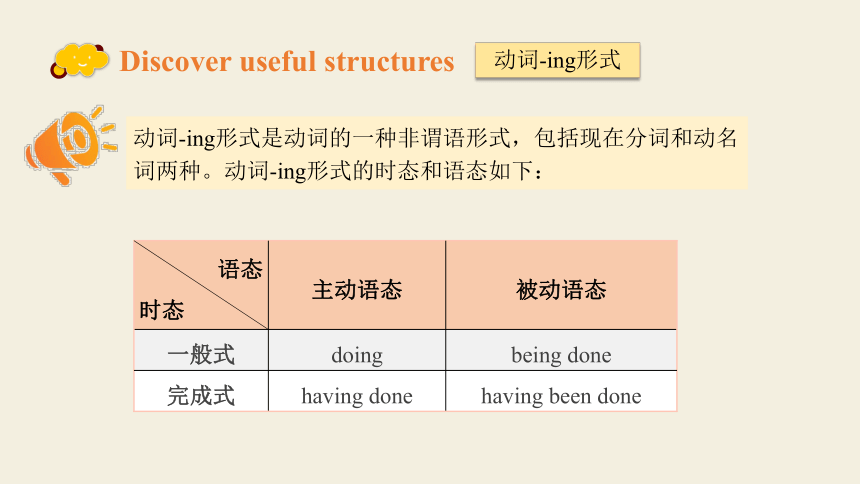
文档简介
(共44张PPT)
Unit 5 First Aid
Learning About Language
Build up your vocabulary
Discover useful structures
C
ONTENTS
目 录
Part 1
Part 2
Review of words and sentences
1. n.( 人或动植物的)器官
2. n. 光线;光束;(热、电等)射线
3. n. 辐射;放射线
4. n. 酸 adj. 酸的;酸性的
5. n. 层;表层;层次
6. n. 受害者;患者
7. prep. & adv. 在……底下;隐藏在下面
8. vt. & vi. 吞下;咽下
organ
ray
radiation
acid
layer
victim
underneath
swallow
Review of words and sentences
9. vt. 包、裹;(用手臂等)围住
10. n. 毫米;千分之一米
→ n. 米
11. adj. 较小的;次要的;轻微的
→ n. 少数;少数派;少数人
→ (反义词) adj. 主要的;重要的;大的;严重的
→ n. 大部分;大多数
12. adj. 电的;用电的;电动的
→ n. 电
→ adj. 电的;与电有关的
→ adj. 电子的
millimetre
metre
minor
minority
majority
electricity
electric
electrical
electronic
wrap
major
Review of words and sentences
13. vi. (swelled,swollen)膨胀;肿胀
→ adj. (身体部位)肿起的;肿胀的
14. n. 神经
→ adj. 紧张的
15. adj. 松的;未系紧的;宽松的
→ v. (使)放松,变松;解开
16. adj. 紧急的;急迫的;急切的
→ v. 敦促;催促;力劝
→ n. 紧迫;急迫
17. vi. & vt. (使)宽慰;减轻;缓解
n. 容易;舒适;自在
→ adj. 容易的;简单的
swell
swollen
nerve
nervous
loose
loosen
urgent
urge
urgency
ease
easy
Review of words and sentences
1. __________________, getting burnt can lead to very serious injuries.
正如你能想象的,被烧伤可能导致非常严重的损伤。
2. __________________ by a variety of things: ...
你可能会被各种各样的东西烧伤:……
3. Burns are divided into three types, _____________________________________.
根据皮肤损伤的深度,烧伤或烫伤可分为三种类型。
4. Remove any clothes using scissors if necessary, ___________________________
___________________.
除非你看到布料粘在烧伤的皮肤上,否则都要把它脱掉,必要时可使用剪刀。
As you can imagine
You can get burnt
depending on the depth of skin damage
unless you see the fabric sticking
to the burnt skin
Build up your vocabulary
1 ___________ a part of the body that has a particular purpose, such as the heart or the brain
2 ___________ a chemical, usually a liquid, that has a pH of less than seven
3 ___________ one thousandth of a metre
4 ___________ energy sent out in waves
5 ___________ material used for making cloth, curtains, etc.
6 ___________ a person who has been attacked, injured, or killed
Task 1 Write a word you have learnt in this unit before each definition.
organ
acid
millimetre
radiation/rays
fabric
victim
Build up your vocabulary
Task 2 Choose the right word(s) from A-C to complete each short conversation.
1 A: The price for this car Fifteen thousand dollars out the door! What a deal!
B: Well, if the car hadn’t been in an accident, that would be a good price, but it has a few _________ problems.
A slight B minor C tiny
2 A: Ouch! My leg really hurts!
B: Why don’t you take some medicine to _________ the pain
A reduce B relax C ease
A/B
A/C
Build up your vocabulary
3 A: Have you treated any real emergencies in your first-aid course at the Red Cross
B: Well, they let us ride along with some paramedics. Once, we gave first aid to a _________ of a traffic accident before rushing him to the hospital.
A victim B patient C sufferer
4 A: Did you hear that three people died in a fire last night
B: What a terrible _________! How did it happen
A accident B incident C occasion
5 A: Can I see you for a moment
B: Is it a matter of _________
A urgency B emergency C seriousness
A
A
A
Build up your vocabulary
incident loose urgent organ acid victim
Task 3 Read the passage about chemical burns and fill in the blanks with the correct forms of the words in the box.
A chemical burn occurs when your skin or eyes come into contact with an _________ or other chemicals. Such _________ can be very dangerous and require _________ attention. Chemical burns can even affect your internal ____________ if the chemicals are swallowed. First aid should be given to chemical burns immediately. For example, wrap the burnt area _________ with a clean cloth if possible. It is important to send the _________ to the hospital right away if he or she is severely burnt.
acid
incidents
urgent
organs
loosely
victim
Discover useful structures
1. As you can imagine, getting burnt can lead to very serious injuries.
2. The first and most important step in the treatment of burns is giving first aid.
3. It’s best to place burns under cool running water, especially within the first ten minutes.
4. Remove any clothes using scissors if necessary, unless you see the fabric sticking to the burnt skin.
5. You can protect the burnt area by covering it with a loose clean cloth.
指出下列动词-ing形式在句子中分别作什么成分。
作宾语
作主语
作表语
作定语
作状语;作宾语补足语
Discover useful structures
动词-ing形式
动词-ing形式是动词的一种非谓语形式,包括现在分词和动名词两种。动词-ing形式的时态和语态如下:
语态 时态 主动语态 被动语态
一般式 doing being done
完成式 having done having been done
Discover useful structures
动词-ing形式
动词-ing形式的功能总结
动词-ing形式 主语 宾语 表语 定语 宾补 状语
动名词(doing)
现在分词(doing)
Discover useful structures
动词-ing形式作主语
动词-ing形式作主语时,往往表示经常性、习惯性的动作,通常置于句首。
Reading aloud is a good way to learn a language.
大声朗读是学习语言的一种好方法。
Wasting a person’s time is the same as killing him for his property.
浪费别人的时间无异于谋财害命。
动词-ing形式
Discover useful structures
动词-ing形式作主语
(1) 不定式作主语表示具体的或一次性的动作。
To lie to her is wrong.
对她撒谎不对。
(2) 动名词作主语时,谓语动词用单数。
Climbing mountains is really difficult for the old.
对于老人来说爬山确实困难。
注意:
动词-ing形式
Discover useful structures
动词-ing形式作宾语
(1) 常接动词-ing形式作宾语的动词有:
避免错过少延期(avoid, miss, postpone)
建议完成多练习(advise/suggest, finish, practise)
喜欢想象禁不住(enjoy, imagine, can’t help)
承认否定与嫉妒(admit, deny, envy)
逃避冒险莫原谅(escape, risk, excuse)
忍受保持不介意(stand, keep, mind)
动词-ing形式
Discover useful structures
动词-ing形式作宾语
Would you mind opening the window
你介意打开窗子吗?
I don’t like watching television but I enjoy listening to the radio.
我不喜欢看电视,但是喜欢听收音机。
He tried to avoid answering my questions.
他试图对我的问题避而不答。
例句
动词-ing形式
Discover useful structures
动词-ing形式作宾语
(2) 常见的跟动词-ing形式作宾语的动词短语有:
insist on, object to, be good at, be fond of, lead to, put off, give up, look forward to, feel like, devote...to, get/be used to, pay attention to, be worth等。
He insisted on doing it in his own way.
他坚持要按照自己的方法做。
动词-ing形式
Discover useful structures
动词-ing形式作宾语
(3) 在有些动词的后面(如start,begin,continue等)既可接动名词也可接不定式作宾语,两者意义区别不大。
They continued working/to work as if nothing had happened.
他们继续工作,似乎什么也没发生过。
(4) 有些动词(短语)后跟不定式和动词-ing形式作宾语均可, 但含义不同。常见的有:
动词-ing形式
Discover useful structures
动词-ing形式作宾语
宾语的形式 意义 宾语的形式 意义
forget to do 忘记做…… regret to do 遗憾/抱歉要做……
forget doing 忘记做过…… regret doing 后悔做了……
remember to do 记着要去做…… try to do 尽力做……
remember doing 记得做过…… try doing 尝试做……
动词-ing形式
Discover useful structures
动词-ing形式作宾语
宾语的形式 意义
mean to do 打算做……
mean doing 意味着……
go on to do 接着做(另外一件事)
go on doing 接着做(同一件事)
stop to do 停下来去做……
stop doing 停止做……
Please remember to give my best regards to your family.
请记着代我向你的家人问好。
I still remember visiting the museum for the first time.
我仍记得第一次参观博物馆的情景。
例句
动词-ing形式
Discover useful structures
动词-ing形式作宾语
(5) 下列动词可接动词-ing形式的主动形式表示被动意义,相当于不定式的被动形式。
need/want/require/deserve doing
=need/want/require/deserve to be done
The bike needs repairing/to be repaired.
这辆自行车需要修理。
动词-ing形式
Discover useful structures
动词-ing形式作表语
作表语的动词-ing形式包括现在分词和动名词。
(1) 现在分词作表语,往往具有形容词的性质,说明主语的性质、特征等。作表语的现在分词,许多是由能够表示人们某种感情或情绪的动词变化而来的。常见的有:moving,interesting,encouraging,exciting,inspiring,boring,surprising,puzzling,amusing,astonishing等。这类分词有“令人……的”的含义,常修饰物。
动词-ing形式
Discover useful structures
动词-ing形式作表语
The argument is very convincing.
这个论点很令人信服。
Your speech is very interesting and encouraging.
你的演讲很有趣而且很鼓舞人。
例句
不定式和动词-ed形式也可作表语,但不定式通常强调一次性的、具体的、将要发生的动作,动词-ed形式则表示被动、完成含义。
注意
动词-ing形式
Discover useful structures
动词-ing形式作表语
(2) 动名词作表语多表示抽象性的或习惯性的动作,一般说明主语的内容。
Her job is keeping the lecture hall as clean as possible.
=Keeping the lecture hall as clean as possible is her job.
她的工作是尽量使报告厅保持干净。
动词-ing形式
Discover useful structures
动词-ing形式作定语
动名词和现在分词都可以作定语,但有所区别。
(1) 动名词作定语表示被修饰词的某种性能或用途,相当于for引导的介词短语。
No one is allowed to speak aloud in the reading room.
阅览室里不准大声说话。
(2) 现在分词作定语时,它和被修饰词之间有逻辑上的主动关系,表示所修饰词进行的动作,相当于一个定语从句。
The boy playing football on the playground is my younger brother.
=The boy that/who is playing football on the playground is my younger brother.
在操场上踢足球的那个男孩是我的弟弟。
动词-ing形式
Discover useful structures
动词-ing形式作定语
现在分词、过去分词和不定式作定语的一般区别:现在分词表示正在进行或习惯性的动作;过去分词表示被动或完成意义;不定式表示动作尚未发生。
You should adapt to the changing situation.
你应该适应不断变化的形势。
The ground is covered with fallen leaves.
地上满是落叶。
I’m looking for a room to live in.
我正在找房子住。
注意:
动词-ing形式
Discover useful structures
动词-ing形式作宾语补足语
动词-ing形式作宾语补足语时,表示正在进行的动作或经常存在的状态。动词-ing形式常作以下动词的宾语补足语。
(1) 表示感觉和心理状态的感官动词(短语),常见的有see,hear,feel,smell,find,notice,observe,look at,listen to。其结构是:动词 + sb. + doing sth. (作宾补)。
I felt somebody standing behind me. 我感觉有人站在我后面。
I saw the little boy crying there. 我看到小男孩在那儿哭。
动词-ing形式
Discover useful structures
动词-ing形式作宾语补足语
(2) 表示指使意义的使役动词,常见的有have,let,keep,get,leave等。其结构是:动词 + sb. /sth. + doing sth. (作宾补)。
We kept the fire burning all night long.
我们让火整夜燃烧着。
I won’t have you running about in the room.
我不允许你在房间里跑来跑去。
动词-ing形式
Discover useful structures
动词-ing形式作宾语补足语
使役动词接现在分词作宾语补足语表示“让……一直做某事”;接不带to的不定式作宾语补足语表示“让某人做某事”;接过去分词作宾语补足语,表示“主语请某人做某事,使完成某事或主语遭遇某事”。
Be careful, or you’ll have your hands hurt.
当心,否则你会弄伤手的。
注意:
动词-ing形式
Discover useful structures
动词-ing形式作宾语补足语
(3) 用于with复合结构中。
I couldn’t do my homework with the noise going on.
由于噪音不断,我没法做家庭作业。
With so many people looking at her, she felt nervous.
这么多人看着她,她感到紧张。
动词-ing形式
Discover useful structures
现在分词作状语
现在分词(短语)在句中作状语来修饰谓语动词或整个句子,表示动作发生的时间、原因、条件、结果、方式、让步或伴随状况。
(1) 作时间状语,相当于一个时间状语从句。
Walking in the park, she saw an old friend.
=When/While (she was) walking in the park, she saw an old friend.
当她在公园里散步时,她看到了她的一个老朋友。
当表示正在进行的动作时,可直接在分词前面加上when/while,此时也可理解为状语从句的省略。
动词-ing形式
Discover useful structures
现在分词作状语
(2) 作原因状语,一般可转换成由as或because引导的原因状语从句。
Being ill, he couldn’t go to school.
=As he was ill, he couldn’t go to school.
因为生病了,他无法去上学。
(3) 作条件状语,一般放在句首,可转换成由if,unless等连词引导的条件状语从句。
Working hard, you’ll make great progress.
=If you work hard, you’ll make great progress.
如果你努力工作,你将取得很大进步。
动词-ing形式
Discover useful structures
现在分词作状语
(4) 作结果状语。现在分词作结果状语时,通常放在句末,中间用逗号隔开,表示一种顺其自然、意料之中的结果。
The hospital has recently obtained new medical equipment, allowing more patients to be treated.
这家医院最近得到一批新的医疗设备,这使更多的病人能得到治疗。
动词-ing形式
Discover useful structures
现在分词作结果状语,是随着谓语动词的发生而产生的自然结果,其逻辑主语往往是前面整个句子所描述的情况,前面有时候可以加thus。而不定式作结果状语时常表示出乎意料的结果,有时前面可以加only。试比较:
He was caught in the rain, thus making himself catch a cold.
被雨淋后他感冒了。
I hurried to school, only to find it was Sunday.
我匆忙赶到学校,结果发现是星期天。
注意:
动词-ing形式
现在分词作状语
Discover useful structures
现在分词作状语
(5) 作让步、方式和伴随状语
现在分词作让步、方式和伴随状语时,说明动作发生的背景和情况。作伴随状语时,表示分词的动作和主句的动作同时发生,此时它可转换成并列句。
Mary sat by the window of the classroom, reading a book.
=Mary sat by the window of the classroom and was reading a book.
玛丽坐在教室的窗边读一本书。
动词-ing形式
Discover useful structures
现在分词作状语
(1) 为强调动词-ing形式表达的意义,可在其前加上各种连词。例如,加上when,while,强调与谓语动词同时发生;加上before,after,强调动作先后发生;加上thus,强调结果;加上though/although,强调让步等。
Though knowing all this, they made me pay for the damage.
尽管他们了解这一切,但还是让我赔偿损失。
(2) 当现在分词的动作先发生,而谓语动词的动作后发生时,用分词的完成式。
Having finished the letter, he went to post it.
他写完信后就把它寄了出去。(having finished是先发生的,went是后发生的)
注意:
动词-ing形式
Discover useful structures
现在分词作状语
(3) 动词-ing形式的否定式:not + v.-ing;not having + v.-ed
Not knowing this, he didn’t come.
他不知道这件事,所以没来。
Not having made full preparations, we put off the sports meeting.
因为没有做好充分的准备,我们把运动会延期了。
(4) 有些现在分词在句中没有逻辑主语,它们往往作为句子的评注性状语来修饰整个句子,表明说话者的态度、观点等。例如:generally speaking “一般来说”,judging by/from...“从……来判断”,taking everything into consideration“从全盘考虑”。
Judging from his behaviour, he must be mad.
从他的行为来判断,他一定是疯了。
注意:
动词-ing形式
动词-ing形式练习
用动词-ing形式改写下列句子:
1. When he got out of the bathtub, he slipped and fell on the floor.
2. Is there any reason why we are not going to have the first-aid training this week
3. She had been told about the risk of electric shocks and this made her very careful while using hairdryers.
When getting out of the bathtub, he slipped and fell on the floor.
Is there any reason for not having the first-aid training this week
Having been told about the risk of electric shocks, she was very careful while using hairdryers.
动词-ing形式练习
用动词-ing形式改写下列句子:
4. Because the child was not watched carefully by his parents, he touched a hot iron and burnt his finger.
5. After she had been bitten by mosquitoes, she applied some medicine to her skin.
Not being watched carefully by his parents, the child touched a hot iron and burnt his finger.
After being/having been bitten by mosquitoes, she applied some medicine to her skin.
动词-ing形式练习
用所给单词的正确形式填空:
Mrs Taylor was an elderly woman __________ (live) alone. One day, she was in her living room cleaning the windows, when suddenly she could no longer feel the right side of her body. __________ (try) to walk to her sofa to sit down, she fell over onto the carpet. Then she realised that she could not get up, and that she was having trouble __________(breathe). Fortunately, she had her mobile phone with her, and she was able to reach it with her left hand while __________ (lie) on the floor. Her mobile phone ________________ (already, set up) to call an emergency number at the push of a button, so it was easy to call for help.
living
Trying
breathing
lying
was already set up
动词-ing形式练习
While attempting to talk to the operator, Mrs Taylor discovered that she could not speak. __________ (not, hear) an answer, the operator knew that Mrs Taylor must be in trouble. Telling Mrs Taylor that everything would be OK, she immediately sent an ambulance. After __________ (arrive), the ambulance team quickly found Mrs Taylor and without delay gave her oxygen, put in an Ⅳ needle, and checked her vital signs. _________________ (take) to the hospital and treated immediately, Mrs Taylor’s health was in no great danger, though she had to stay in the hospital ward. After a week, her __________ (frighten) experience was over, and she was allowed to go home.
Not hearing
arriving
Having been taken
frightening
1 What should people do when facing a frightening experience like Mrs Taylor’s
2 What are some risks that elderly people may encounter when living alone
3 What can we do to help prevent elderly people from taking unnecessary risks
When having a frightening experience like Mrs Taylor’s, people should try to get help, like she did.
When living alone, elderly people may fall or get injured, and not be able to help themselves or even call for help.
To help prevent elderly people from taking unnecessary risks, we should make sure that their homes are easy to get around in, with handrails, ramps instead of stairs, and even walking surfaces.
Work in pairs and discuss the following questions.
Assignment
Thank You!
Unit 5 First Aid
Learning About Language
Build up your vocabulary
Discover useful structures
C
ONTENTS
目 录
Part 1
Part 2
Review of words and sentences
1. n.( 人或动植物的)器官
2. n. 光线;光束;(热、电等)射线
3. n. 辐射;放射线
4. n. 酸 adj. 酸的;酸性的
5. n. 层;表层;层次
6. n. 受害者;患者
7. prep. & adv. 在……底下;隐藏在下面
8. vt. & vi. 吞下;咽下
organ
ray
radiation
acid
layer
victim
underneath
swallow
Review of words and sentences
9. vt. 包、裹;(用手臂等)围住
10. n. 毫米;千分之一米
→ n. 米
11. adj. 较小的;次要的;轻微的
→ n. 少数;少数派;少数人
→ (反义词) adj. 主要的;重要的;大的;严重的
→ n. 大部分;大多数
12. adj. 电的;用电的;电动的
→ n. 电
→ adj. 电的;与电有关的
→ adj. 电子的
millimetre
metre
minor
minority
majority
electricity
electric
electrical
electronic
wrap
major
Review of words and sentences
13. vi. (swelled,swollen)膨胀;肿胀
→ adj. (身体部位)肿起的;肿胀的
14. n. 神经
→ adj. 紧张的
15. adj. 松的;未系紧的;宽松的
→ v. (使)放松,变松;解开
16. adj. 紧急的;急迫的;急切的
→ v. 敦促;催促;力劝
→ n. 紧迫;急迫
17. vi. & vt. (使)宽慰;减轻;缓解
n. 容易;舒适;自在
→ adj. 容易的;简单的
swell
swollen
nerve
nervous
loose
loosen
urgent
urge
urgency
ease
easy
Review of words and sentences
1. __________________, getting burnt can lead to very serious injuries.
正如你能想象的,被烧伤可能导致非常严重的损伤。
2. __________________ by a variety of things: ...
你可能会被各种各样的东西烧伤:……
3. Burns are divided into three types, _____________________________________.
根据皮肤损伤的深度,烧伤或烫伤可分为三种类型。
4. Remove any clothes using scissors if necessary, ___________________________
___________________.
除非你看到布料粘在烧伤的皮肤上,否则都要把它脱掉,必要时可使用剪刀。
As you can imagine
You can get burnt
depending on the depth of skin damage
unless you see the fabric sticking
to the burnt skin
Build up your vocabulary
1 ___________ a part of the body that has a particular purpose, such as the heart or the brain
2 ___________ a chemical, usually a liquid, that has a pH of less than seven
3 ___________ one thousandth of a metre
4 ___________ energy sent out in waves
5 ___________ material used for making cloth, curtains, etc.
6 ___________ a person who has been attacked, injured, or killed
Task 1 Write a word you have learnt in this unit before each definition.
organ
acid
millimetre
radiation/rays
fabric
victim
Build up your vocabulary
Task 2 Choose the right word(s) from A-C to complete each short conversation.
1 A: The price for this car Fifteen thousand dollars out the door! What a deal!
B: Well, if the car hadn’t been in an accident, that would be a good price, but it has a few _________ problems.
A slight B minor C tiny
2 A: Ouch! My leg really hurts!
B: Why don’t you take some medicine to _________ the pain
A reduce B relax C ease
A/B
A/C
Build up your vocabulary
3 A: Have you treated any real emergencies in your first-aid course at the Red Cross
B: Well, they let us ride along with some paramedics. Once, we gave first aid to a _________ of a traffic accident before rushing him to the hospital.
A victim B patient C sufferer
4 A: Did you hear that three people died in a fire last night
B: What a terrible _________! How did it happen
A accident B incident C occasion
5 A: Can I see you for a moment
B: Is it a matter of _________
A urgency B emergency C seriousness
A
A
A
Build up your vocabulary
incident loose urgent organ acid victim
Task 3 Read the passage about chemical burns and fill in the blanks with the correct forms of the words in the box.
A chemical burn occurs when your skin or eyes come into contact with an _________ or other chemicals. Such _________ can be very dangerous and require _________ attention. Chemical burns can even affect your internal ____________ if the chemicals are swallowed. First aid should be given to chemical burns immediately. For example, wrap the burnt area _________ with a clean cloth if possible. It is important to send the _________ to the hospital right away if he or she is severely burnt.
acid
incidents
urgent
organs
loosely
victim
Discover useful structures
1. As you can imagine, getting burnt can lead to very serious injuries.
2. The first and most important step in the treatment of burns is giving first aid.
3. It’s best to place burns under cool running water, especially within the first ten minutes.
4. Remove any clothes using scissors if necessary, unless you see the fabric sticking to the burnt skin.
5. You can protect the burnt area by covering it with a loose clean cloth.
指出下列动词-ing形式在句子中分别作什么成分。
作宾语
作主语
作表语
作定语
作状语;作宾语补足语
Discover useful structures
动词-ing形式
动词-ing形式是动词的一种非谓语形式,包括现在分词和动名词两种。动词-ing形式的时态和语态如下:
语态 时态 主动语态 被动语态
一般式 doing being done
完成式 having done having been done
Discover useful structures
动词-ing形式
动词-ing形式的功能总结
动词-ing形式 主语 宾语 表语 定语 宾补 状语
动名词(doing)
现在分词(doing)
Discover useful structures
动词-ing形式作主语
动词-ing形式作主语时,往往表示经常性、习惯性的动作,通常置于句首。
Reading aloud is a good way to learn a language.
大声朗读是学习语言的一种好方法。
Wasting a person’s time is the same as killing him for his property.
浪费别人的时间无异于谋财害命。
动词-ing形式
Discover useful structures
动词-ing形式作主语
(1) 不定式作主语表示具体的或一次性的动作。
To lie to her is wrong.
对她撒谎不对。
(2) 动名词作主语时,谓语动词用单数。
Climbing mountains is really difficult for the old.
对于老人来说爬山确实困难。
注意:
动词-ing形式
Discover useful structures
动词-ing形式作宾语
(1) 常接动词-ing形式作宾语的动词有:
避免错过少延期(avoid, miss, postpone)
建议完成多练习(advise/suggest, finish, practise)
喜欢想象禁不住(enjoy, imagine, can’t help)
承认否定与嫉妒(admit, deny, envy)
逃避冒险莫原谅(escape, risk, excuse)
忍受保持不介意(stand, keep, mind)
动词-ing形式
Discover useful structures
动词-ing形式作宾语
Would you mind opening the window
你介意打开窗子吗?
I don’t like watching television but I enjoy listening to the radio.
我不喜欢看电视,但是喜欢听收音机。
He tried to avoid answering my questions.
他试图对我的问题避而不答。
例句
动词-ing形式
Discover useful structures
动词-ing形式作宾语
(2) 常见的跟动词-ing形式作宾语的动词短语有:
insist on, object to, be good at, be fond of, lead to, put off, give up, look forward to, feel like, devote...to, get/be used to, pay attention to, be worth等。
He insisted on doing it in his own way.
他坚持要按照自己的方法做。
动词-ing形式
Discover useful structures
动词-ing形式作宾语
(3) 在有些动词的后面(如start,begin,continue等)既可接动名词也可接不定式作宾语,两者意义区别不大。
They continued working/to work as if nothing had happened.
他们继续工作,似乎什么也没发生过。
(4) 有些动词(短语)后跟不定式和动词-ing形式作宾语均可, 但含义不同。常见的有:
动词-ing形式
Discover useful structures
动词-ing形式作宾语
宾语的形式 意义 宾语的形式 意义
forget to do 忘记做…… regret to do 遗憾/抱歉要做……
forget doing 忘记做过…… regret doing 后悔做了……
remember to do 记着要去做…… try to do 尽力做……
remember doing 记得做过…… try doing 尝试做……
动词-ing形式
Discover useful structures
动词-ing形式作宾语
宾语的形式 意义
mean to do 打算做……
mean doing 意味着……
go on to do 接着做(另外一件事)
go on doing 接着做(同一件事)
stop to do 停下来去做……
stop doing 停止做……
Please remember to give my best regards to your family.
请记着代我向你的家人问好。
I still remember visiting the museum for the first time.
我仍记得第一次参观博物馆的情景。
例句
动词-ing形式
Discover useful structures
动词-ing形式作宾语
(5) 下列动词可接动词-ing形式的主动形式表示被动意义,相当于不定式的被动形式。
need/want/require/deserve doing
=need/want/require/deserve to be done
The bike needs repairing/to be repaired.
这辆自行车需要修理。
动词-ing形式
Discover useful structures
动词-ing形式作表语
作表语的动词-ing形式包括现在分词和动名词。
(1) 现在分词作表语,往往具有形容词的性质,说明主语的性质、特征等。作表语的现在分词,许多是由能够表示人们某种感情或情绪的动词变化而来的。常见的有:moving,interesting,encouraging,exciting,inspiring,boring,surprising,puzzling,amusing,astonishing等。这类分词有“令人……的”的含义,常修饰物。
动词-ing形式
Discover useful structures
动词-ing形式作表语
The argument is very convincing.
这个论点很令人信服。
Your speech is very interesting and encouraging.
你的演讲很有趣而且很鼓舞人。
例句
不定式和动词-ed形式也可作表语,但不定式通常强调一次性的、具体的、将要发生的动作,动词-ed形式则表示被动、完成含义。
注意
动词-ing形式
Discover useful structures
动词-ing形式作表语
(2) 动名词作表语多表示抽象性的或习惯性的动作,一般说明主语的内容。
Her job is keeping the lecture hall as clean as possible.
=Keeping the lecture hall as clean as possible is her job.
她的工作是尽量使报告厅保持干净。
动词-ing形式
Discover useful structures
动词-ing形式作定语
动名词和现在分词都可以作定语,但有所区别。
(1) 动名词作定语表示被修饰词的某种性能或用途,相当于for引导的介词短语。
No one is allowed to speak aloud in the reading room.
阅览室里不准大声说话。
(2) 现在分词作定语时,它和被修饰词之间有逻辑上的主动关系,表示所修饰词进行的动作,相当于一个定语从句。
The boy playing football on the playground is my younger brother.
=The boy that/who is playing football on the playground is my younger brother.
在操场上踢足球的那个男孩是我的弟弟。
动词-ing形式
Discover useful structures
动词-ing形式作定语
现在分词、过去分词和不定式作定语的一般区别:现在分词表示正在进行或习惯性的动作;过去分词表示被动或完成意义;不定式表示动作尚未发生。
You should adapt to the changing situation.
你应该适应不断变化的形势。
The ground is covered with fallen leaves.
地上满是落叶。
I’m looking for a room to live in.
我正在找房子住。
注意:
动词-ing形式
Discover useful structures
动词-ing形式作宾语补足语
动词-ing形式作宾语补足语时,表示正在进行的动作或经常存在的状态。动词-ing形式常作以下动词的宾语补足语。
(1) 表示感觉和心理状态的感官动词(短语),常见的有see,hear,feel,smell,find,notice,observe,look at,listen to。其结构是:动词 + sb. + doing sth. (作宾补)。
I felt somebody standing behind me. 我感觉有人站在我后面。
I saw the little boy crying there. 我看到小男孩在那儿哭。
动词-ing形式
Discover useful structures
动词-ing形式作宾语补足语
(2) 表示指使意义的使役动词,常见的有have,let,keep,get,leave等。其结构是:动词 + sb. /sth. + doing sth. (作宾补)。
We kept the fire burning all night long.
我们让火整夜燃烧着。
I won’t have you running about in the room.
我不允许你在房间里跑来跑去。
动词-ing形式
Discover useful structures
动词-ing形式作宾语补足语
使役动词接现在分词作宾语补足语表示“让……一直做某事”;接不带to的不定式作宾语补足语表示“让某人做某事”;接过去分词作宾语补足语,表示“主语请某人做某事,使完成某事或主语遭遇某事”。
Be careful, or you’ll have your hands hurt.
当心,否则你会弄伤手的。
注意:
动词-ing形式
Discover useful structures
动词-ing形式作宾语补足语
(3) 用于with复合结构中。
I couldn’t do my homework with the noise going on.
由于噪音不断,我没法做家庭作业。
With so many people looking at her, she felt nervous.
这么多人看着她,她感到紧张。
动词-ing形式
Discover useful structures
现在分词作状语
现在分词(短语)在句中作状语来修饰谓语动词或整个句子,表示动作发生的时间、原因、条件、结果、方式、让步或伴随状况。
(1) 作时间状语,相当于一个时间状语从句。
Walking in the park, she saw an old friend.
=When/While (she was) walking in the park, she saw an old friend.
当她在公园里散步时,她看到了她的一个老朋友。
当表示正在进行的动作时,可直接在分词前面加上when/while,此时也可理解为状语从句的省略。
动词-ing形式
Discover useful structures
现在分词作状语
(2) 作原因状语,一般可转换成由as或because引导的原因状语从句。
Being ill, he couldn’t go to school.
=As he was ill, he couldn’t go to school.
因为生病了,他无法去上学。
(3) 作条件状语,一般放在句首,可转换成由if,unless等连词引导的条件状语从句。
Working hard, you’ll make great progress.
=If you work hard, you’ll make great progress.
如果你努力工作,你将取得很大进步。
动词-ing形式
Discover useful structures
现在分词作状语
(4) 作结果状语。现在分词作结果状语时,通常放在句末,中间用逗号隔开,表示一种顺其自然、意料之中的结果。
The hospital has recently obtained new medical equipment, allowing more patients to be treated.
这家医院最近得到一批新的医疗设备,这使更多的病人能得到治疗。
动词-ing形式
Discover useful structures
现在分词作结果状语,是随着谓语动词的发生而产生的自然结果,其逻辑主语往往是前面整个句子所描述的情况,前面有时候可以加thus。而不定式作结果状语时常表示出乎意料的结果,有时前面可以加only。试比较:
He was caught in the rain, thus making himself catch a cold.
被雨淋后他感冒了。
I hurried to school, only to find it was Sunday.
我匆忙赶到学校,结果发现是星期天。
注意:
动词-ing形式
现在分词作状语
Discover useful structures
现在分词作状语
(5) 作让步、方式和伴随状语
现在分词作让步、方式和伴随状语时,说明动作发生的背景和情况。作伴随状语时,表示分词的动作和主句的动作同时发生,此时它可转换成并列句。
Mary sat by the window of the classroom, reading a book.
=Mary sat by the window of the classroom and was reading a book.
玛丽坐在教室的窗边读一本书。
动词-ing形式
Discover useful structures
现在分词作状语
(1) 为强调动词-ing形式表达的意义,可在其前加上各种连词。例如,加上when,while,强调与谓语动词同时发生;加上before,after,强调动作先后发生;加上thus,强调结果;加上though/although,强调让步等。
Though knowing all this, they made me pay for the damage.
尽管他们了解这一切,但还是让我赔偿损失。
(2) 当现在分词的动作先发生,而谓语动词的动作后发生时,用分词的完成式。
Having finished the letter, he went to post it.
他写完信后就把它寄了出去。(having finished是先发生的,went是后发生的)
注意:
动词-ing形式
Discover useful structures
现在分词作状语
(3) 动词-ing形式的否定式:not + v.-ing;not having + v.-ed
Not knowing this, he didn’t come.
他不知道这件事,所以没来。
Not having made full preparations, we put off the sports meeting.
因为没有做好充分的准备,我们把运动会延期了。
(4) 有些现在分词在句中没有逻辑主语,它们往往作为句子的评注性状语来修饰整个句子,表明说话者的态度、观点等。例如:generally speaking “一般来说”,judging by/from...“从……来判断”,taking everything into consideration“从全盘考虑”。
Judging from his behaviour, he must be mad.
从他的行为来判断,他一定是疯了。
注意:
动词-ing形式
动词-ing形式练习
用动词-ing形式改写下列句子:
1. When he got out of the bathtub, he slipped and fell on the floor.
2. Is there any reason why we are not going to have the first-aid training this week
3. She had been told about the risk of electric shocks and this made her very careful while using hairdryers.
When getting out of the bathtub, he slipped and fell on the floor.
Is there any reason for not having the first-aid training this week
Having been told about the risk of electric shocks, she was very careful while using hairdryers.
动词-ing形式练习
用动词-ing形式改写下列句子:
4. Because the child was not watched carefully by his parents, he touched a hot iron and burnt his finger.
5. After she had been bitten by mosquitoes, she applied some medicine to her skin.
Not being watched carefully by his parents, the child touched a hot iron and burnt his finger.
After being/having been bitten by mosquitoes, she applied some medicine to her skin.
动词-ing形式练习
用所给单词的正确形式填空:
Mrs Taylor was an elderly woman __________ (live) alone. One day, she was in her living room cleaning the windows, when suddenly she could no longer feel the right side of her body. __________ (try) to walk to her sofa to sit down, she fell over onto the carpet. Then she realised that she could not get up, and that she was having trouble __________(breathe). Fortunately, she had her mobile phone with her, and she was able to reach it with her left hand while __________ (lie) on the floor. Her mobile phone ________________ (already, set up) to call an emergency number at the push of a button, so it was easy to call for help.
living
Trying
breathing
lying
was already set up
动词-ing形式练习
While attempting to talk to the operator, Mrs Taylor discovered that she could not speak. __________ (not, hear) an answer, the operator knew that Mrs Taylor must be in trouble. Telling Mrs Taylor that everything would be OK, she immediately sent an ambulance. After __________ (arrive), the ambulance team quickly found Mrs Taylor and without delay gave her oxygen, put in an Ⅳ needle, and checked her vital signs. _________________ (take) to the hospital and treated immediately, Mrs Taylor’s health was in no great danger, though she had to stay in the hospital ward. After a week, her __________ (frighten) experience was over, and she was allowed to go home.
Not hearing
arriving
Having been taken
frightening
1 What should people do when facing a frightening experience like Mrs Taylor’s
2 What are some risks that elderly people may encounter when living alone
3 What can we do to help prevent elderly people from taking unnecessary risks
When having a frightening experience like Mrs Taylor’s, people should try to get help, like she did.
When living alone, elderly people may fall or get injured, and not be able to help themselves or even call for help.
To help prevent elderly people from taking unnecessary risks, we should make sure that their homes are easy to get around in, with handrails, ramps instead of stairs, and even walking surfaces.
Work in pairs and discuss the following questions.
Assignment
Thank You!
